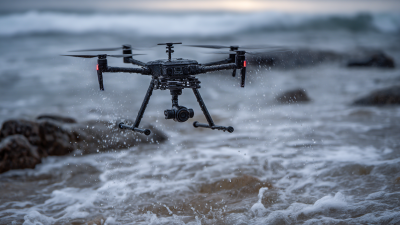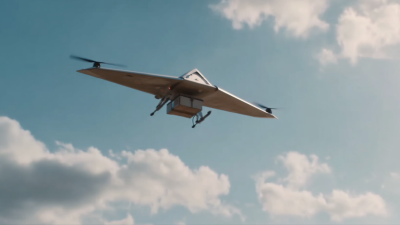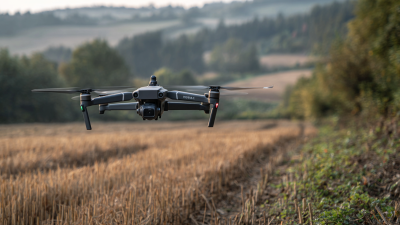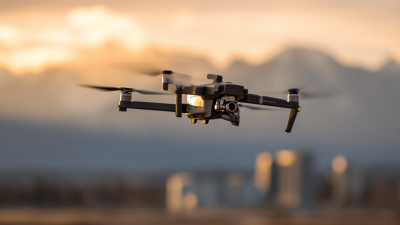Leave Your Message
The advent of waterproof drones has transformed the landscape of aerial photography, particularly in challenging wet conditions. As the demand for high-quality visuals continues to rise, these innovative tools are proving to be game-changers for photographers and filmmakers alike. Industry expert Dr. Emily Harris, a leading figure in drone technology, states, "Waterproof drones open up new possibilities for capturing stunning visuals in environments that were once considered impractical." Her words reflect a growing belief in the potential of these drones to redefine the boundaries of creative expression in photography, even in the heart of storms or over majestic water bodies.

As aerial photographers push the envelope of their craft, waterproof drones offer unparalleled flexibility and resilience. Whether it’s capturing breathtaking shots during a rainy season or taking dynamic images above lakes and oceans, these drones not only withstand the elements but also deliver exceptional clarity and detail. The technological advancements in drone design and functionality are empowering photographers to explore new heights—including conditions that would have previously limited their work. This exploration highlights the synergy between technology and artistry, where waterproof drones become essential tools for capturing the beauty of nature in all its forms.
The evolution of waterproof drone technology has significantly transformed the landscape of aerial photography, particularly in challenging environments. Traditionally, photographers were constrained by weather conditions, with rain and moisture posing threats to sensitive equipment. However, advancements in drone design and materials have led to the development of waterproof drones that can withstand harsh conditions, opening up new possibilities for capturing stunning imagery in all kinds of weather.
These drones are equipped with specialized features that enhance their durability and functionality. Enhanced seals, hydrophobic coatings, and the integration of robust components ensure that they can operate effectively during rain or in humid environments. As a result, photographers can now shoot dynamic landscapes, coastal scenes, and even underwater footage with confidence. The integration of waterproof technology has not only expanded the creative potential for artists but has also paved the way for commercial applications in sectors like agriculture, wildlife monitoring, and search-and-rescue operations, where weather conditions often pose significant challenges.
In recent years, waterproof drones have emerged as game-changers in the realm of aerial photography, particularly in rainy conditions. These drones allow photographers and videographers to capture stunning visuals despite the challenging weather, thus expanding the possibilities for outdoor shoots. The ability to operate in wet environments not only enhances creative opportunities but also ensures that filmmakers and photographers do not miss out on capturing unique moments due to unpredictable weather.
When using waterproof drones, there are several advantages to consider. First, they can operate seamlessly in various weather conditions, enabling shoots during the magical golden hour even when rain is imminent. Second, the durability of these drones minimizes the risk of damage from moisture, making them a reliable choice for professionals who often film in unpredictable climates. Lastly, the advanced technology in waterproof drones allows for clearer images and stable footage, elevating the overall quality of the work produced.
Tips for Using Waterproof Drones:
As waterproof drones gain momentum in the aerial photography industry, they are opening up a plethora of iconic shooting spots that were previously challenging to access. A recent report indicates that the global drone market is projected to reach over $40 billion by 2025, highlighting a surge in demand for innovative features and enhanced usability, particularly in diverse weather conditions. This evolution is not just limited to consumer drones; professionals are leveraging waterproof capabilities to capture breathtaking landscapes, from coastal cliffs to misty waterfalls, where traditional drones would struggle.
With advancements in technology, these waterproof models are equipped with high-resolution cameras and stabilization systems that ensure stunning image quality even amidst rain or high humidity. The ability to operate in wet conditions expands the creative possibilities for photographers, allowing them to explore new venues that showcase the beauty of nature in different weathers. Industry analysts emphasize that as manufacturers continue to innovate, the accessibility of these spots combined with improved drone features will drive an even greater interest in aerial photography, pushing creatives to capture unique perspectives that were once deemed inaccessible.
When it comes to aerial photography in wet conditions, using waterproof drones can significantly enhance the quality and reliability of your shots. According to a report from the Drone Industry Association, the demand for drones designed for adverse weather has increased by 35% over the past two years, indicating a growing awareness of their advantages in expanding creative possibilities. To make the most of these tools, photographers should learn to harness the unique environmental conditions that wet weather provides, such as dramatic lighting and rich colors.
One of the key techniques is to utilize reflections created by wet surfaces. Puddles and wet ground can act as mirrors, providing stunning symmetry and unique perspectives. It's also crucial to ensure that your drone's camera settings are optimized for lower light conditions often found during rain. Professionals recommend using a higher ISO setting but being cautious of noise levels. Finally, keeping your lens clean and free of water spots will prevent any obstruction in your images. By employing these strategies, photographers can transform challenging weather into an opportunity for captivating visuals, leading to a more dynamic portfolio.
| Aspect | Details |
|---|---|
| Drone Type | Waterproof Drones (IP67 or higher) |
| Camera Resolution | 4K Video, 20MP Photos |
| Flight Time | Up to 30 minutes |
| Best Usage Conditions | Rain, Humidity, Overcast Skies |
| Techniques | Utilize ND filters for exposure, Shoot in RAW, Maintain steady flight altitude |
| Post-Processing Software | Adobe Lightroom, Photoshop |
| Key Considerations | Battery management during wet conditions, Regular maintenance and drying after flight |
The integration of waterproof drones into professional photography services is reshaping the landscape of aerial imagery. As photographers face increasing demand for versatile and high-quality content, these drones provide an invaluable tool for capturing stunning visuals in challenging environments. Whether it’s a rainy day on a film set or a misty landscape for a nature shoot, waterproof drones empower professionals to seize opportunities that were previously hindered by weather conditions. By eliminating the limitation of rain and moisture, photographers can expand their creative horizons and deliver unique perspectives that enhance their portfolios.
Looking ahead, the future of waterproof drones in photography appears promising. The technological advancements in drone design, coupled with improved camera capabilities, will likely lead to more photographers incorporating these devices into their workflows. Furthermore, as clients seek more dynamic and engaging content, the ability to capture aerial shots in any weather condition will become a significant competitive advantage. Professional photography services that adopt waterproof drones early will not only meet contemporary market demands but also set trends for innovative approaches to aerial photography in the years to come.






